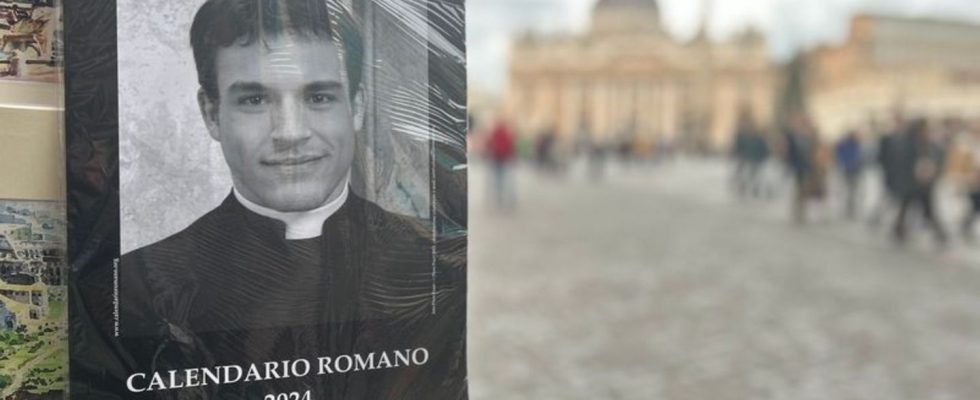Church
Whether real or not: The calendar of the beautiful priests
The “Calendario Romano” at a souvenir stand, with St. Peter’s Basilica in the background. photo
© Christoph Sator/dpa
Officially it is called “Calendario Romano”, but in Rome everyone knows it as the Calendar of the Beautiful Priests. On the occasion of the 20th anniversary, it now comes out: The man on the cover is not a clergyman at all.
Now, in the last weeks of the year, the man is once again one of the most famous faces in the Eternal City. In the souvenir shops and souvenir shops around the The new “Calendario Romano” for 2024 is currently hanging everywhere in the Vatican. The same young man with a collar and a cassock, an extremely friendly face of the Roman Catholic Church, smiles on the cover like all the years before. The black robe with a white stand-up collar is practically the everyday clothing for clergy here. It’s just that the men are usually a bit older and don’t always look quite as happy.
The “Roman Calendar” was first published in 2004. According to the cover page, month after month you can discover a different man in church clothes, all of them similarly young and similarly attractive. Over the years, the print has become one of the best-selling souvenirs from the Italian capital. It is now on every continent. This probably has less to do with the fact that the calendar also provides practical information about the Vatican, such as the names of the various popes from Peter to Francis or the opening times of the pharmacy there.
The “pin-up priest” isn’t one at all
The reason for the sales success is probably that men of the month like to be portrayed with subtle eroticism. Older tourists are reminded of the television series “The Thorn Birds” with Richard Chamberlain, who played a priest who loves a woman a little more than his God. The calendar is also popular with gays. In any case, hardly anyone calls him by his real name. It is better known as the calendar of the beautiful priests or the “Preti Pin-Up” (“Pin-Up Priest”).
However, on the occasion of the 20th anniversary, it emerged that the previously anonymous man on the cover is not a cleric at all – and never was. In reality it is a Sicilian named Giovanni Galizia, who now works as a steward for a Spanish airline. When the photo was taken, in front of a church in Palermo – not Rome – Galizia was 17. He is now 37.
The “March Priest” is a real estate agent
At that time, Galizia modeled for an amateur photographer friend from Venice, Piero Pazzi. His idea was to photograph Italian cities with their classic characters: Venice with gondoliers, Rome with priests. “I never thought that the photo would still be in circulation after 20 years,” Galizia just told the newspaper “El País”. A guilty conscience because he pretended to be a priest? Not at all. “I didn’t do anything bad. I just posed for a photo, nothing more.”
In fact, many probably suspected right from the start that not everything in the calendar is as it seems. A few years ago it came out that the “March Priest” – a man in full regalia – was a real estate agent from Spain. Many people also had doubts about the man on the title. In the meantime, rumors circulated that he had renounced celibacy and gotten married or that he had died from drugs. Galizia is doing well. But some priests are also real: “August,” for example, a priest from Poland.
The Vatican has had no objection to the “Calendario Romano” over the years. At best, the church emphasizes that it is an “individual initiative”. The calendar currently costs eight euros. Tens of thousands of them are lost in Rome every year, always sealed in plastic. The owner of a souvenir stand with a view of St. Peter’s Basilica says: “The calendars with the current Pope sell best. But the beautiful priests are a perennial favorite.”
The “nuns” edition did not sell
In any case, business is going so well that calendar maker Pazzi has no intention of stopping. He also wants to bring out another one for the “Holy Year” of 2025, when a particularly large number of visitors are expected in Rome. The “Calendario Romano” is now also available on the Internet. In principle, it has remained unchanged over the years, as can be seen, for example, in hairstyle fashion. Sometimes the photographer even receives requests from real priests who would like to be there: The “August Priest” from Poland made it into the calendar.
In view of the great success with the priests – whether real or not – Pazzi had also tried a calendar with nuns. But the women’s edition didn’t sell particularly well. The experiment was then immediately over.

